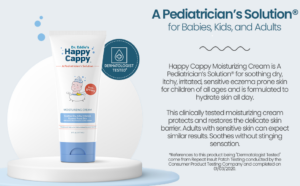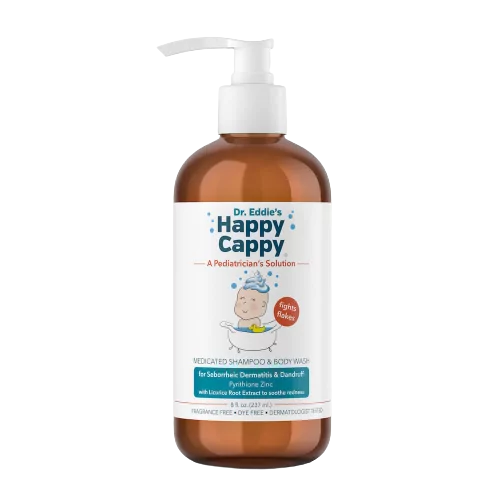
By Dr. Eddie Valenzuela
Do you or anyone you know have itchy palms or itchy feet? If so, you may have a form of eczema called Dyshidrotic Eczema. This itchy diagnosis goes by many names. It can be referred to as Hand Eczema, dyshidrosis, vesiculobullous dermatitis, or acute Palmoplantar Eczema and is also called Pompholyx.
What Is Dyshidrotic Eczema?
Itchy—check. Have you ever looked at your hands and wondered why they look like there are really small flesh-colored or clear beads on the sides of some or all of your fingers or on the palms of your hands?
The itching, followed by the development of vesicles or small bumps, is a typical symptom of Dyshidrotic Eczema. It is a chronic skin condition that causes small, itchy blisters to form on hands, feet, and fingers.
These symptoms, in some cases, may disappear with time and never come back. However, in some cases, they may reappear again throughout life in the form of flare-ups. People used to think that hyperactive sweat glands caused this condition, but the scientific community now believes otherwise.
Dyshidrotic Eczema Causes?
The exact cause of dyshidrotic eczema is unknown, but people with excessive sweating of the hands and feet are more prone to developing it. It is also thought that changes in seasons can cause a flare-up. A physician will also likely ask about exposures to metals like cobalt and nickel and look for evidence of fungal infections as sometimes these can cause other forms of dermatitis on the hands
Symptoms Of Dyshidrotic Eczema
The symptoms of Dyshidrotic Eczema usually appear on the
- Palms
- Sides of the fingers
- Soles of feet
- On the toes
Some of the common symptoms of Pompholyx are:
- Itchy skin
- Small blisters
- Scaly skin
- Excess sweating around blisters
- Dry skin
- Burning sensation
- Change of nail color
These symptoms may vary from person to person depending on the severity of the condition. However, if you are unsure about anything, it is best to consult a dermatologist to get an accurate diagnosis of your condition.
Who Is At Risk?
Dyshidrotic eczema can affect anyone but it is more common in
- People between the ages of 20 and 40
- Family history of eczema, contact dermatitis, asthma, and allergies
- Females are more likely to develop it than males.
- People who receive Intravenous immunoglobulin (protective antibody injection).
Even though these people are more prone to developing dyshidrotic, this does not mean others can not develop it. Eczema can affect anyone at any time.
How Is Dyshidrotic Eczema Diagnosed?
If you suspect you are experiencing small blisters and fluid-filled bumps on your hands and feet, then consult a dermatologist. You are most likely to be experiencing dyshidrotic eczema.
The dermatologist or your healthcare provider will first physically examine your symptoms and inquire about your and your family’s health history of eczema.
If still unsure, the doctor may prescribe a skin biopsy or blood test to make sure these blisters are not caused by any other skin condition. They may also perform a patch test to figure out which irritant is causing your dyshidrotic eczema.
Dyshidrotic Eczema Treatment
Even though dyshidrotic eczema is a chronic skin condition and there is no permanent cure for it, there are certain things you can do to soothe the itching and irritation on the skin and prevent future flare-ups.
- Use lukewarm water instead of hot water when washing your hands and feet, or taking a bath.
- Clean the affected area with a gentle non-soap eczema cleanser every day.
- Make sure to moisturize the skin with an eczema cream at least twice daily.
- Don’t wear socks or gloves that retain moisture in them and keep your hands and feet dry.
- Use a humidifier in cold, dry weather to keep the air moist and prevent your skin from drying up.
- Avoid scratching the blisters; it can cause scarring and infections.
- If you know which allergen might be causing your eczema, then try staying away from it.
- In severe cases, the doctor may prescribe topical corticosteroid cream and antihistamines.

Dyshidrotic Eczema and Happy Cappy
Happy Cappy was made for people with itchy skin conditions like Dyshidrotic Eczema. Skin that is broken and irritated can have a higher pH than normal skin. Many commercially available soaps tend to have high pHs. Which is why they often irritate the skin and make the condition worse.
Using a soap that has a low pH (similar to non-irritated skin) can help normalise the pH of irritated skin and improve skin barrier function.
Happy Cappy Daily Shampoo & Body Wash is an irritant-free cleanser infused with soothing ingredients Provitamin B5, Oatmeal Extract, Aloe Vera, Hyaluronic Acid, Licorice Root Extract, and Glycerin.
These natural ingredients help draw moisture into the skin. This eczema shampoo has the low pH that people with irritated, eczema-prone skin need. And the best part it is free from any of those harsh chemcilas such as fragrances, parabens, sulfates, and dyes that can further exacerbate the condition.
After cleansing your skin with Happy Cappy Shampoo for Eczema your must moisturize the skin using Happy Cappy Moisturizing Cream. It is an hypoallergenic moisturizer that protects and restores the skin barrier.
Happy Cappy’s proprietary formulation uses pharmaceutical-grade white petrolatum with Licorice Root Extract, Glycerin, and other smoothing emulsifiers to make a non-greasy product perfect for reapplying throughout the day.
Conclusion
Eczema is one of the most common skin conditions people experience worldwide. However, there are various different types of eczema and Dyshidrotic Eczema is one of them. This type of eczema usually affects the hands, palms, and sole of the feet.
It causes small fluid-filled, skin-colored blisters to form on the skin. Just like any other eczema it aslo causes the skin to become itchy, irritated, and dry. One of the distinct symptom of Dyshidrotic Eczema is that it can also change the color of your nails.
Even though there is no permanent cure for it, however you can easily amange it and soothe intensity of the symptoms by taking care of your skin. By using Happy Cappy Eczema Shampoo and Body Wash to cleanse your skin at least once daily and Moisturizing it with Happy Cappy Eczema Mositurizing Cream at least twice daily.
FAQs
- Eczema VS Psoriasis: Discovering the Difference - February 24, 2025
- Eczema on Black Skin: Is It Different? - February 24, 2025
- Scalp Health – A Reflection of What We Eat? - February 24, 2025
Is dyshidrotic eczema contagious?
Dyshidrotic eczema is not contagious. It means that this disease cannot spread from one person to another by touching or using the accessories of an affected person. However, it can be caused by sweaty hands and feet.
Can you pop dyshidrotic eczema?
It is not recommended to pop blisters caused by dyshidrotic eczema. Leave them as they are and wait for the skin to make a layer and crack open the blisters automatically. If you scratch or cut the blisters prematurely, it can cause infection and scarring.
What is the fluid in dyshidrotic eczema?
The fluid in the blisters caused by dyshidrotic eczema is called interstitial fluid. This fluid comes near the wound where there is inflammation.
Is dyshidrotic eczema an autoimmune disease?
Technically, Eczema is not an autoimmune disease. However, both share similarities, so people compare it with autoimmune disease. However, studies need to prove its authenticity.
What does dyshidrotic eczema look like?
Dyshidrotic eczema usually causes fluid-filled blisters on the fingers, hands, and feet. In some cases, these blisters can be painful and in most cases they are itchy.
Is dyshidrotic eczema a lifelong disease?
It is a chronic skin condition, meaning it may appear once in your lifetime or be a part of it forever in flare-ups.
What is the permanent cure for dyshidrotic eczema?
There is no permanent cure for eczema as it is a chronic skin condition. But you can easily manage it by keeping your skin clean with the gentle Happy Cappy Daily Shampoo and Body Wash and soothe the itchiness and redness with Happy Cappy Eczema Cream.
How long does dyshidrotic eczema last?
It usually lasts around 3 to 4 weeks with proper care and treatment. In some cases, it may never come again, but sometimes, it becomes a lifelong issue and comes and goes from time to time.
Can dyshidrotic eczema spread to the face?
Dyshidrotic eczema usually targets the hands and feet. It does not spread to the face.











